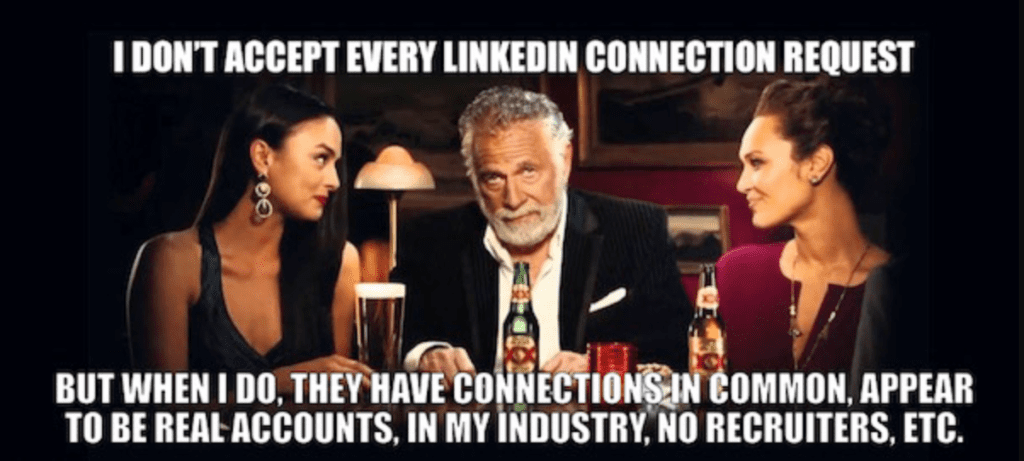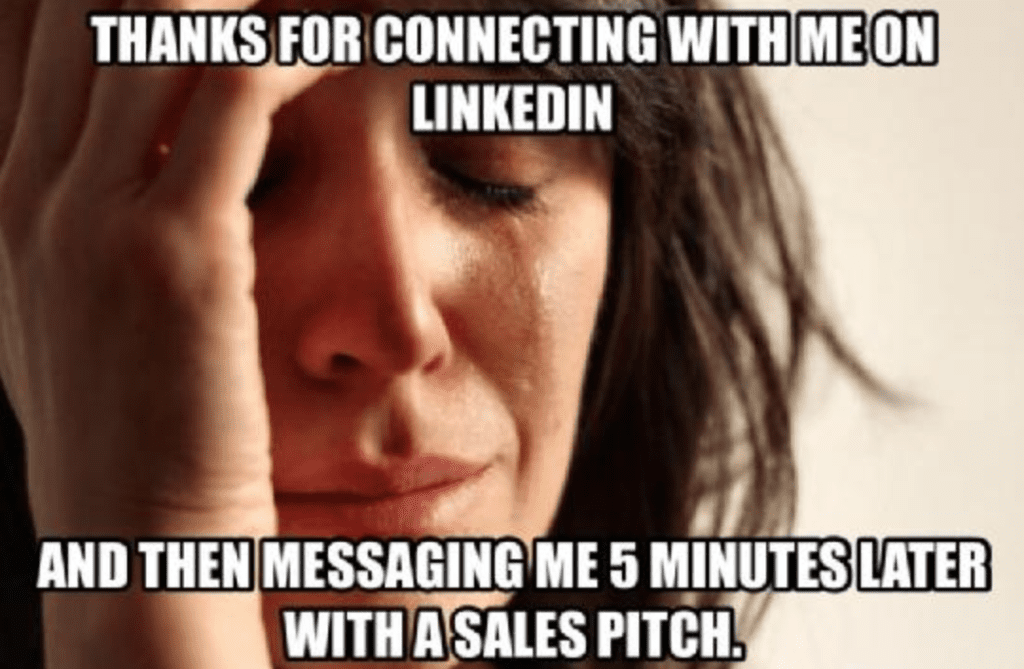There’s no question that over the last few months LinkedIn has seen new life.
The feed is more relevant than ever. The content in front of us is better than ever. And the opportunities for marketers to use LinkedIn as a B2B channel are greater than ever.
That’s why I’ve spent even more time studying and using LinkedIn over the last few months. From breaking down the ins and outs of the LinkedIn algorithm to running content experiments, I’ve been trying anything and everything to better understand how to use LinkedIn for my own purposes and for my clients.
In this time, I’ve had some great wins reaching tens of thousands of people—and I’ve made some mistakes along the way. I’ve also spoken with LinkedIn experts and super-users about what does and doesn’t work. In this post, I’m going to break down a few things in the latter category—LinkedIn no-nos that need to stop.
If you’ve made the mistake of doing any of these things, maybe this is your sign that it’s time to switch things up and use LinkedIn a little more wisely than you have in the past. I’m confident that your LinkedIn experience can become a whole lot more rewarding by walking away from these bad behaviors.
Not Filling Out Your LinkedIn Profile Completely
Just as no one liked being followed by an anonymous egg on Twitter (the site’s old default avatar), no one likes getting requests from faceless characters on LinkedIn.
It doesn’t matter if you have one of the most unusual names in the world—people connect with faces. In fact, studies show that it’s easier to remember someone by their face than by their name. So make it easy for people who meet you at an event to recognize you later when you send an invitation on LinkedIn. Show your face!
But it doesn’t end with your profile pic…
Make it easy for fellow alumni to find you by keeping your college or university up to date. Make it easy for past colleagues and employers to find you by keeping your job history up to date. Make it easy for people who want to work with you to find you by keeping your headline up to date.
Asking For Everything Without Giving Anything
We’re all connected to that person on LinkedIn who is always asking for things but never giving. If they’re using LinkedIn it’s because they need an intro, they need a referral, they need a recommendation, they need a share, they need a comment… They’re constantly asking but rarely giving.
Don’t be that person.
Give the people you’re connected with more value than you try to take from them.
You can give them value by simply making their feed worth reading. Share content that would be interesting to them. Share videos that will help them be more successful. Create status updates that are interesting, insightful and filled with takeaways that will improve their lives.
Let’s say you’re a Portfolio Manager. You can add value to your LinkedIn Network by providing objective market analysis and real-time financial data to help them make better trading decisions. You can also give away free guides and tutorial videos on preparing financial reports, improving returns on investments, and so on.
Sending Requests To Everyone & Their Mailman
I love this image on Marketing Land:
Look: We get it.
Connections matter.
But that doesn’t mean you need to send invite requests to everyone under the sun. Far too many people make the mistake of thinking LinkedIn is a numbers game. It’s not.
In the early days of LinkedIn, you could rely on your network as a way to identify leads and source quality introductions. Today, it’s much less likely that people who are connected to potential leads are actually true business connections at all, and that’s unfortunate.
So rather than sending requests to everyone you follow on Twitter, send requests to people you’ve interacted with. Send requests to people only after you’ve engaged with them in some way, then follow up to nurture the relationship.
Don’t make the mistake of viewing LinkedIn as a numbers game. Remember that quality is always more important than quantity and that your LinkedIn connections should be your biggest advocates.
Using Templated Invitation Requests
Two requests are the definition of laziness:
“I’d like to add you to my professional network”
And…
“Because you’re someone I trust, I’d like to add you to my professional network”
C’monnnnnnnn!
If you’re adding someone you’ve known for years, OK, sure, the first one is fine. But if you’re adding someone you met at an event, collaborated with on a short project or were introduced to by a colleague, make the “personalized’ invite, well, personal.
The perfect formula for a great invitation on LinkedIn is (1) Give context (2) Keep it short (3) Personalize it and (4) Be personable. Let’s break this down:
Give context: Remind the recipient how you know one another. Did you comment on their blog earlier today? Did you run into them at a local conference? Did you hear them speak? Give them context on who you are and why you’re adding them.
Keep it short: LinkedIn has a word count on personalized invites, which is great—BUT that doesn’t mean you always have to max it out. No one needs to know that you have a third degree black belt (I’ve received an invite mentioning that before—I kid you not) or that you’re having avocado toast for lunch. Keep it short and to the point.
Personalize it: People love their own names. Include the recipient’s name in the invitation with a simple “Hey Ross” or “Hi Ross” to give that feeling of personalization.
Be personable: As much as Hollywood paints a picture of business as super formal, it’s really a lot of fun. So don’t be afraid to be personable in your LinkedIn requests. Write a request the same way you would write one to a longtime colleague or peer. Include emojis. Include exclamation marks. Let your guard down and be human! (But keep it professional, please — more on that later.)
Automating Pitches Upon Invite Acceptance
I don’t know which app is giving people the ability to do this, but it needs to stop. I’m sure automated replies work for some people, but there’s no question in my mind that marketing professionals who receive these automated emails after accepting your LinkedIn invite are completely turned off.
I know I am.
And while my sample size is small (and biased), I believe automating replies upon invitation acceptance on LinkedIn is simply lazy, mainly because you can see right through these automated messages—they’re quite generic and templated. If there was a way to make them automated with first name, job title and company name, maybe then I’d consider this option. But as of now, I’m not so sure it’s a great idea for anyone to be leveraging this automation hack.
Calling Yourself A LION (Sorry…It’s Lame)
I really don’t know how else to put it. And this might upset some people but the world of LIONs is dead.
It’s over. It’s gone. It’s lame.
If you’re not familiar with LION, it stands for LinkedIn Open Networker. In this LinkedIn post about the acronym, a LION is described as:
A member of the professional social networking site that encourages connections from any member of the site by publicly declaring they are open networkers. In other words, they are open to connecting with anyone who sends an invitation to them.
Here’s the thing though:
The new LinkedIn algorithm has made the site far more connected. It’s easier than ever for your content to reach thousands of people in different countries. It’s easier than ever for people from other industries to stumble upon your work.
And it’s easier than ever to make meaningful relationships with people from around the world without proclaiming to the world: I’M A LION. HEAR ME ROAR!
Acting Like LinkedIn Is Tinder (Not Sorry… It’s Creepy)
LinkedIn is Not Tinder. LinkedIn is Not Tinder. LinkedIn is Not Tinder. LinkedIn is Not Tinder. LinkedIn is Not Tinder. LinkedIn is Not Tinder. LinkedIn is Not Tinder. LinkedIn is Not Tinder. LinkedIn is Not Tinder. LinkedIn is Not Tinder. LinkedIn is Not Tinder. LinkedIn is Not Tinder. LinkedIn is Not Tinder. LinkedIn is Not Tinder. LinkedIn is Not Tinder. LinkedIn is Not Tinder. LinkedIn is Not Tinder. LinkedIn is Not Tinder. LinkedIn is Not Tinder. LinkedIn is Not Tinder.
In case you don’t believe me when I say that some folks actually think it’s OK to reach out to people with comments on their looks, here’s a few examples of LinkedIn dating attempts in action:
@CRProudman @LinkedIn @Jessica_Asato @ObjectUpdate “you have a nice smile . . . can give me your email . . . ” pic.twitter.com/sOIFxXaaH9
— Jessica (@JFayeSF) September 9, 2015
And….
@CRProudman @LinkedIn just got this creeper in my inbox the other day (this one sounds like a bot) pic.twitter.com/WyFlEZtSvZ
— eileen scully (@eemscully) September 10, 2015
And….
Got this message over @LinkedIn – seriously?! #learnsomemanners #gross #inappropriate #sexist #callingoutsexism pic.twitter.com/xiJU4imKGi
— Joanna Savio (@joannasavio) March 16, 2016
So, yeah… Let’s not do that.
Instead, let’s keep LinkedIn a place where we can expect interactions to have the same level of professionalism that they would (or should) at a corporate event.
Wrapping Things Up
If you’re like me, you’ve been watching the latest growth surrounding LinkedIn and are excited about the channels new found life. If you’re in B2B, there is a plethora of LinkedIn Stats showing us that LinkedIn is a channel that deserves the industries attention.
The key is understanding best practices and, at the very least, knowing how to use the tool correctly. It’s my hope that this blog post offered you some insights about how you can start maximizing your time on LinkedIn to drive meaningful results for you and your business.
What else should people stop doing on Linkedin? I’d love to hear from you in the comments. And if you disagree with any of my points, I have thick skin—I’d love to hear why you think I’m wrong. Let’s discuss!


